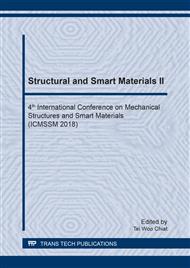[1]
D.N. Brewer, M. Verrilli, A. Calomino, Ceramic matrix composite vane subelement burst testing, In proceedings of ASME TURBO EXPO, Spain, (2006).
DOI: 10.1115/gt2004-53974
Google Scholar
[2]
A. Locaombe, P. Spriet, A. Allaria, E. Bouillon, G. Habarou, Ceramic matrix composites to make breakthroughs in aircraft engine performance, 50th AIAA/ASME/ASCE/AHS/ASC structures, structural dynamics and material conference, California, (2009).
DOI: 10.2514/6.2009-2675
Google Scholar
[3]
D.L. Wu, Three-cell model and 5D braided structural composites, Compos. Sci. Technol. 56 (1996) 225-233.
DOI: 10.1016/0266-3538(95)00136-0
Google Scholar
[4]
I. Vandeurzen, Structure-performance analysis of two-dimensional woven fabric composite, 10th International Conference on Composite Material, Canada, 1983, pp.261-268.
Google Scholar
[5]
T. Noda, A. Kohyama, Y. Katoh, Recent progress of SiC-fibers and SiC/SiC-composites for fusion applications, Phys. Scripta. 1 (2001) 124-129.
DOI: 10.1238/physica.topical.091a00124
Google Scholar
[6]
P. Sangsuwan, J.A. Orejas, J.E. Gatica, S.N. Tewari, M. Singh, Reaction-bonded silicon carbide by reactive infiltration, Ind. Eng. Chem. Res. 40 (2001) 5191-5198.
DOI: 10.1021/ie001029e
Google Scholar
[7]
M. Kotani, A. Kohyama, K. Okamura, T. Inoue, Fabrication of high performance SiC/SiC composite by polymer impregnation and pyrolysis method, Ceramic. Eng. Sci. Proc. 20(1999) 309-316.
DOI: 10.1002/9780470294574.ch36
Google Scholar
[8]
M. Kotani, T. Inoue, A. Kohyama, K. Okamura, Y. Katoh. Consolidation of polymer-derived SiC matrix composites: processing and microstructure, Compos. Sci. Technol. 357 (2003) 376-385.
DOI: 10.1016/s0921-5093(03)00206-5
Google Scholar
[9]
W. Yang, H. Araki, A. Kohyama, Q. Yang. Effects of heat treatment on the microstructure and flexural properties of CVI-Tyranno-SA/SiC composite, Ceram. Int. 33 (2007) 141-146.
DOI: 10.1016/j.ceramint.2005.08.011
Google Scholar
[10]
Y. Katoh, T. Nozawa, L.L. Snead, T. Hinoki, A. Kohyama, Property tailorability for advanced CVI silicon carbide composites for fusion, Fusion. Eng. Des. 81 (2006) 937-944.
DOI: 10.1016/j.fusengdes.2005.08.045
Google Scholar
[11]
Y. Katoh, S.M. Dong, A. Kohyama, Thermo-mechanical properties and microstructure of silicon carbide composites fabricated by nano-infiltrated transient eutectoid process, Fusion. Eng. Des. 61 (2002) 723-731.
DOI: 10.1016/s0920-3796(02)00180-1
Google Scholar
[12]
Y. Katoh, A. Kohyama, T. Nozawa, M. Sato, SiC/SiC composites through transient eutectic-phase route for fusion applications, J. Nucl. Mater. 329 (2004) 587-591.
DOI: 10.1016/j.jnucmat.2004.04.157
Google Scholar
[13]
H.L. Wang, X.G. Zhou, J.S. Yu, Y.B. Cao, R.J. Liu, Microstructure mechanical properties and reaction mechanism of KD-I SiCf/SiC composites fabricated by chemical vapor infiltration and vapor silicon infiltration, Mat. Sci. Eng. 528 (2011) 2441-2445.
DOI: 10.1016/j.msea.2010.12.028
Google Scholar
[14]
H.L. Wang, X.G. Zhou, Y.B. Cao, J.S. Yu, R.J. Liu. Fabrication of SiCf/SiC composites by chemical vapor infiltration and vapor silicon infiltration, Mater. Lett. 64 (2010) 1691-1693.
DOI: 10.1016/j.matlet.2010.05.013
Google Scholar
[15]
W. Yang, H. Araki, A. Kohyama, Q. Yang, Effects of heat treatment on the microstructure and flexural properties of CVI-Tyranno-SA/SiC composite, Ceram. Int. 33 (2007) 141-146.
DOI: 10.1016/j.ceramint.2005.08.011
Google Scholar
[16]
G.D Fang, J. Liang, Y. Wang, The effect of yarn distortion on the mechanical properties of 3D four-directional braided composites, Compos. Part A, 40 (2009) 343-350.
DOI: 10.1016/j.compositesa.2008.12.007
Google Scholar
[17]
C.C. Chamis, Mechanics of composite materials - Past, present and future, J. Compos. Technol. Res. 11 (1) (1989) 3-14.
Google Scholar
[18]
H.Y. Sun, X. Qiao, Prediction of the mechanical properties of three-dimensionally braided composites, Comp. Sci. Tech. 57 (1997) 623-629.
DOI: 10.1016/s0266-3538(96)00154-6
Google Scholar
[19]
X. Sun, C. Sun, Mechanical properties of three-dimensional braided composites, Comp. Struct. 65 (2004) 485-492.
DOI: 10.1016/j.compstruct.2003.12.009
Google Scholar
[20]
D.L. Wu, Three-cell model and 5d braided structural composites, Comp. Sci. Tech. 56 (1996) 225-233.
DOI: 10.1016/0266-3538(95)00136-0
Google Scholar
[21]
J.C. Michel, H. Moulinec, P. Suquet, Effective properties of composite materials with periodic microstructure: a computational approach, Comp. Methods. Appl. Mech. Eng. 172 (1-4) (1999), 109-143.
DOI: 10.1016/s0045-7825(98)00227-8
Google Scholar
[22]
S. Li, Boundary conditions for unit cells from periodic microstructures and their implications, Compos. Sci. Technol. 68 (9) (2008) 1962-1974.
Google Scholar
[23]
Z. Xia, Y. Zhang, F. Ellyin, A unified periodical boundary conditions for representative volume elements of composites and applications, Int. J. Solids. Struct. 40 (2003) 1907-1921.
DOI: 10.1016/s0020-7683(03)00024-6
Google Scholar


